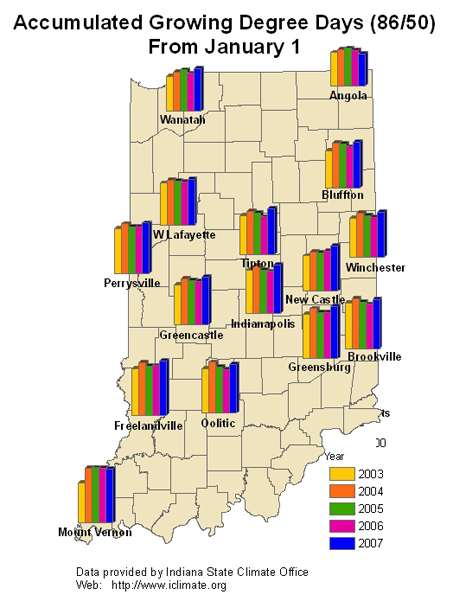Pest & Crop Newsletter, Entomology Extension, Purdue University
- No Surprise, Spider Mites Respoinding to Dry Conditions
- Soybean Aphid Update
- Black Light Trap Catch Report
![]()
No Surprise, Spider Mites Responding to Dry Conditions - (Christian Krupke, John Obermeyer, and Larry Bledsoe)
- Spider mites can now be found in droughty soybean fields.
- Stressed areas of fields will show damage first.
- Consider many factors before treating spider mites.
- Ground applied applications, because crop dusters are booked, can actually do a better job because of the increased carrier used.
According to the U.S. Drought Monitor (<http:drought.unl.edu/dm>), as of July 10, 80% of Indiana is abnormally dry, with 32% of that in the first stages of drought. Some area saw some relief with rains this week, but the rains unfortunately missed most of the driest counties in the north-eastern part of the state. It should come as no surprise that twospotted spider mites have begun to move into and colonize thirsty soybeans. Foliage damage from spider mite feeding is expressed initially as subtle stippling, which may progress to a bronzing and necrosis should dry conditions persist and mites are left unchecked. Bronzed foliage is irreversible, meaning the damage is done!

Yellowish stippling, early signs of spider mite feeding
Before considering control, it is very important that spider mites are identified as the source of yellowish or bronzed plants in a field. There are many other diseases, pathogens and nutrient defiencies that cause a similar appearance of foliage. To confirm the presence of mites, shake some discolored soybean leaves over a white piece of paper. Watch for small dark specks moving about on the paper. Also look for very tiny, fine webbing on the undersides of the discolored leaves. Once spider mites have been positively identified in the damaged areas of the field, it is essential that the portions of the entire field be scouted to determine the range of infestation – spider mites are very patchy in colonizing fields and are often restricted to borders. Sample in at least five different areas of the field and determine how far the spider mites have moved into the field from the grassy borders by using the “leaf-shake” method.
Stressed plants actually provide a more nutritionous feast for spider mites than healthy plants do. Thus they thrive and quickly colonize large areas or whole fields. The best spider mite control is to eliminate plant stress, which is easier said than done. Sandy, high clay, or compacted soils will exacerbate moisture stress in plants, with or without the presence of spider mites. Other stresses on soybean include pests such as soybean cyst nematode or nutritional imbalances, such as manganese deficiency. Obviously the best plant stress reliever under dry conditions is rain. Significant rain doesn’t control spider mites but helps the soybean plant become more vigorous and healthy, which in turn makes the “juices” of the plant less nutritious to the mites, and makes mites less likely to reproduce as quickly.

Bronzing, severe spider mite damage
The most severe damage occurs when the infestation starts in the early stages of plant growth and builds throughout the season (extended drought). Before applying controls carefully consider that, depending when damage is noted, multiple insecticide/miticide applications may be necessary. This is because surviving spider mites are able to repopulate a field much more quickly than their natural predators, which are usually also wiped out by these chemical applications. If extensive leaf discoloration is apparent, spider mites are positively identified as the culprit, and hot, dry conditions are expected to persist, it is recommended that a control be considered.
If a control is warranted, two pesticides are recommended for use. These include dimethoate (Dimethoate 400 and 4 EC) and chlorpyrifos (Lorsban 4E and generics). Dimethoate is the most efficacious of these compounds for mite control. If soybean aphid is also present in the field, then chlorpyrifos would be a good choice to suppress both pests. Neither of these products will control spider mite eggs, however, and each will provide a maximum of 7 days of residual activity. Proper placement of these pesticides is the key to successful control results. Nozzle pressures of 40 psi with fine to medium droplet size and 30-40 gallons of water per acre for ground application helps distribute the pesticide throughout the foliage.
 Watch a short video on spider mite scouting and proper identification.
Watch a short video on spider mite scouting and proper identification.
![]()
Soybean Aphid Update - (Christian Krupke, John Obermeyer, and Larry Bledsoe)
From a historical standpoint with soybean aphid, the next two weeks are critical. Most soybean fields are entering the early pod development stages when stress needs to be avoided, including sucking insects. Soybean aphid numbers continue to creep upward throughout the Midwest, but very few fields have been found over threshold (≥250 aphids/plant). None have been reported over threshold in Indiana.
After many weeks of low or no aphids, we have begun to see aphid numbers trend upward in the northeastern counties, south of Fort Wayne. We are still well below threshold, at under 100 aphids/plant - but this situation bears watching. With high aphid numbers in parts of Michigan this year, if we see an outbreak, it is likely to occur in northeastern Indiana.
As always, we recommend scouting every soybean field, as dramatic field-to-field variability in aphid numbers continues to be noted. Understand that this situation can change quickly, be aware. Check the national aphid map at <www.sbrusa.net> for updates on sentinel plot counts of aphids and soybean rust. Happy scouting!
![]()
Click here to view the
Black Light Trap Catch Report - (John Obermeyer)
![]()
Frogeye Leaf Spot - (Greg Shaner)
- Despite dry weather, some frogeye leaf spot is showing up in soybean.
As part of a national soybean rust-monitoring program, we have 20 soybean sentinel plots throughout Indiana. Each week, we inspect 100 leaflets from each of these plots. Fortunately, we have found no rust, but these leaf samples also provide a snapshot of other foliar diseases. Most samples contain some leaves with symptoms of brown spot. This is a common disease on lower leaves, but during most of the season, the plant stays ahead of it. Brown spot tends to remain down in the canopy until late in the season. We have found frogeye leaf spot lesions in samples from White, Tippecanoe, and Jennings Counties in the past few days. Incidence is low—only 1 to 3 leaves out of a hundred. Like many foliar diseases, frogeye leaf spot is favored by wet, humid weather, so it’s surprising that we have seen any this year.
The fungus Cercospora sojina causes frogeye leaf spot. Symptoms on leaves are fairly distinctive. Lesions are round to angular, up to 5 mm in diameter (Fig. 1). The lesion has a dark red brown border and a tan center. The surface of the lesion on the underside of the leaf is somewhat darker. Small, dark patches can be seen in the centers of lesions when they are examined with a hand lens. These are fascicles of dark conidiophores, the structures on which spores are produced. If an infected leaf is held up to the sky to provide backlighting, yellow halos can be seen around the dark lesions (Fig. 2). The dead tissue in the center of old lesions may fall out.
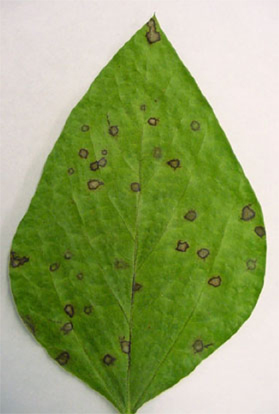
Fig. 1. Frogeye leaf spot lesions on soybean seen with incident light

Fig. 2. Frogeye lesions seen with blacklighting. Note yellow borders around the dark margins of the lesions.
Leaves are most susceptible when they are young. Fully expanded leaves are much more resistant. All leaf layers may show frogeye, or there may be some layers with disease, and other layers with little or no disease—a reflection of different weather conditions as each successive leaf layer emerged.
There is resistance to frogeye leaf spot. Cercospora sojina consists of several races, distinguished by their ability or inability to cause disease on soybean varieties that carry different genes for resistance. Soybean varieties that carry the Rcs3 gene appear to have effective resistance against all of the races in Indiana. In an outbreak of frogeye leaf spot in 2005, which extended into northern Indiana, some varieties proved to be very susceptible and probably sustained considerable loss of yield. Although we are getting some much-needed rain now, precipitation over the next 2 weeks is predicted to be below normal for most of Indiana. This would not favor continued development of frogeye leaf spot even on susceptible varieties. However, if frogeye leaf spot is seen in a field, it would be a good idea to find out how susceptible or resistant the variety is. If the variety is susceptible, continue to monitor the disease.
Potential for Corn Recovery from Drought Stress? - (Bob Nielsen)
As the latest round of thunderstorms tease drought-stricken areas of Indiana with the hope of meaningful rainfall, growers are wondering whether renewed soil moisture at this point in the season will markedly benefit their drought-stressed corn crops. The simple answer is “yes”, but the magnitude of the yield benefits will vary depending on the severity of damage already done to the crop.
In some areas of the state, drought-stressed corn is 2 to 3 feet tall and struggling to put out tassels and silks. Such severe examples of drought stress undoubtedly also translate to potential ear sizes that have already been severely compromised, in which case perfect weather from this point forward will only preserve the limited yield potential remaining in these fields.
How severely has yield been limited in such severely stressed fields? The severity of drought stress in many fields is too variable to easily estimate yield loss on a whole field basis. Within areas of some fields, eventual yield loss may be nearly 100% either due to outright death of plants or total failure of pollination or total abortion of ears. Within less severely stressed areas of the same fields, yield potential will range all over the map due to variability for potential ear size, success during pollination, and kernel survival following pollination (Nielsen, 2007a).
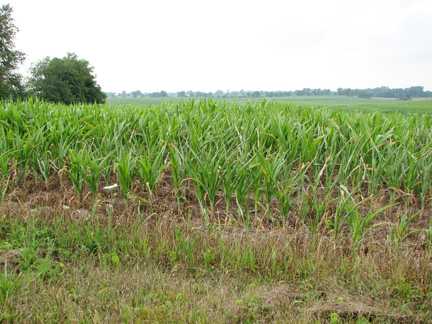
Droughty corn and field edge, Steuben County (Photo credit: Rusty Papsdorf)
Agronomists often point out that ear length potential is more easily affected by stress than row number potential during the ear size determination phase prior to pollination (Nielsen, 2007b). However, that does not mean that row number determination is immune to the effects of drought stress. It is not uncommon to find potential kernel row numbers on ear shoots dissected from plants in severely stressed fields that are 4 to 6 fewer than normal. For a normally 16-row hybrid, such reductions in kernel row number translate to reductions in yield potential of 25 to 38%. Coupled with likely reductions in ear length potential, the yield potential in such severely stressed fields is quite low regardless of future rainfall.
Admittedly, there are areas of the state where crops look much better and have suffered only marginal drought stress to date. Rainfall received in these areas will help sustain a relatively good yield potential by better ensuring favorable conditions through the remainder of the grain filling period. If near-drought conditions prevail in fields with reasonably good yield potential, one consequence will be a heightened risk of weakened stalks or outright stalk rot development if plants resort to remobilizing (aka cannibalizing) stored carbohydrate reserves from the stalk tissue to the developing kernels over the next 30 days or so (Nielsen, 2005).
Related References
Nielsen, R.L. (Bob). 2005. Monitor Corn Fields for Weakened or Diseased Stalks. Corny News Network, Purdue Univ. [On-Line]. Available at <http://www.kingcorn.org/news/articles.05/StalkMonitoring-0823.html>(URL accessed 7/18/07).
Nielsen, R.L. (Bob). 2007a. Assessing Effects of Drought on Corn Grain Yield? Corny News Network, Purdue Univ. [On-Line]. Available at <http://www.kingcorn.org/news/articles.07/Drought-0705.html> (URL accessed 7/18/07).
Nielsen, R.L. (Bob). 2007b. Ear Size Determination in Corn. Corny News Network, Purdue Univ. [On-Line]. Available at <http://www.kingcorn.org/news/timeless/EarSize.html> (URL accessed 7/18/07).
Nielsen, R.L. (Bob). 2007c. Estimating Corn Grain Yield Prior to Harvest. Corny News Network, Purdue Univ. [On-Line]. Available at <http://www.kingcorn.org/news/timeless/YldEstMethod.html> (URL accessed 7/18/07).
Nielsen, R.L. (Bob). 2007d. Kernel Set Scuttlebutt. Corny News Network, Purdue Univ. [On-Line]. Available at <http://www.kingcorn.org/news/timeless/KernelSet.html> (URL accessed 7/18/07).
![]()
Corn Fungicide Hoopla - (Bob Nielsen)
Hoopla: hoop·la (hoop’lä’, hoop’-) n. Informal
1. Boisterous, jovial commotion or excitement.
2. Extravagant publicity:
3. Talk intended to mislead or confuse.
Hoopla. Dictionary.com. The American Heritage® Dictionary of the English Language, Fourth Edition. Houghton Mifflin Company, 2004. <http://dictionary.reference.com/browse/hoopla> (accessed: July 13, 2007).
Based on the heated discussions overheard at the counter down at the Chat ‘n Chew Cafe,interest in fungicide applications on field corn is at an all-time high this summer. The nature of the “hoopla” over corn fungicides runs the gamut of the various definitions of the word if you listen long enough to the debates.
If you’ve been watching the aerial applicators at work in your neighborhood and are wondering whether you should jump on the bandwagon, I’ve compiled a few links to recent Web articles from university Extension specialists that may shed a proverbial “third party” perspective on the subject.
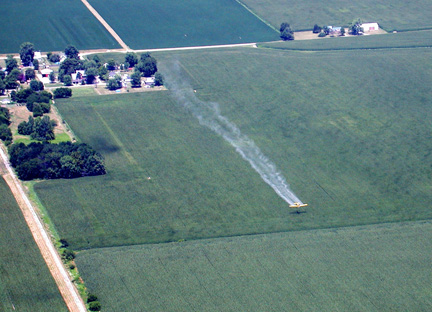
References
Robertson, Alison and Daren Mueller. 7/11/07. Fungicide application to corn at tasseling. <http://www.agronext.iastate.edu/corn/showitem.php?id=50> Iowa State Univ.
Mueller, Daren. 5/15/06. Fungicides: Terminology.
<http://www.ipm.iastate.edu/ipm/icm/2006/5-15/fungicides.html> Iowa State Univ. The first of an 8-part series. A good primer on fungicides for non-plant pathologists.
Jackson, Tamra. 7/13/07. Results of Nebraska Foliar Fungicide Trials on Corn. <http://cropwatch.unl.edu/archives/2007/crop18/corn_fungicides.htm> Univ. of Nebraska.
Shaner, Greg. 7/13/07. Corn Disease Update. <http://extension.entm.purdue.edu/pestcrop/2007/issue16/index.html#corn> Purdue Univ.
Sweets, Laura. 7/13/07. Foliar Fungicides Labeled for Use on Field Corn. <http://ipm.missouri.edu/ipcm/archives/v17n14/ipmltr3.htm> Univ. of Missouri.
Malvick, Dean. 7/12/07. Corn Foliar Diseases and Fungicides in Minnesota – Delving into the Uncertain. <http://www.extension.umn.edu/cropenews/2007/07MNCN31.htm> Univ. of Minnesota.
Brown-Rytlewski, Diane. 7/12/07. Fungicide applications of strobilurins to corn and soybeans when there is little disease. <http://www.ipm.msu.edu/cat07field/fc07-12-07.htm#4> Michigan State Univ.
Dorrance, Anne, Pierce Paul, & Dennis Mills. 7/9/07. So You Are Trying Fungicides On Corn And Soybeans, How To Evaluate If They Are Worth The Cost? <http://corn.osu.edu/index.php?setissueID=192#B> Ohio State Univ.
Vincelli, Paul. 7/2/07. Questions on Fungicides in a Dry Growing Season. <http://www.uky.edu/Ag/kpn/kpn_07/pn070702.htm#corque> Univ. of Kentucky.
Shaner, Greg. 6/29/07. Will Fungicides Be of Value on Corn This Year? <http://extension.entm.purdue.edu/pestcrop/2007/issue14/index.html#fungicides> Purdue Univ.
Robertson, Alison, Daren Mueller, Carol Pilcher and Kristine Schaefer. 6/25/07. Fungicide applications in corn may be increasing. <http://www.ipm.iastate.edu/ipm/icm/2007/6-25/fungicides.html> Iowa State Univ.
Nafziger, Emerson. 6/29/07. Can Foliar Fungicide Raise Corn Yield When There’s Little Disease? <http://www.ipm.uiuc.edu/bulletin/article.php?id=793> Univ. of Illinois.
Bradley, Carl and Matt Montgomery. 6/8/07. Prophylactic Fungicide Applications on Corn: A Good Practice? <http://www.ipm.uiuc.edu/bulletin/article.php?id=758> Univ. of Illinois.
Paul, Pierce. 5/28/07. 5/21/07. Foliar Fungicide Use in Corn. <http://corn.osu.edu/story.php?setissueID=180&storyID=1083> Ohio State Univ.
Larson, Erick. 5/14/07. Fungicides on Corn? <http://www.msstate.edu/dept/drec/news/2007/corn/corn_disease.pdf> Mississippi State Univ.
Vincelli, Paul. 4/30/07. Fungicide considerations for corn in 2007. <http://www.uky.edu/Ag/kpn/kpn_07/pn070430.htm#corfun> Univ. of Kentucky.
![]()
Kernel Set Scuttlebutt - (Bob Nielsen)
“Scuttlebutt”: The cask of drinking water on ships was called a scuttlebutt and since sailors exchanged gossip when they gathered at the scuttlebutt for a drink of water, scuttlebutt became U.S. Navy slang for gossip or rumors. A butt was a wooden cask, which held water or other liquids; to scuttle is to drill a hole, as for tapping a cask.
Nautical Terms and Phrases, NAVAL HISTORICAL CENTER, Washington DC 20374-5060.
Online at <http://www.ussbrainedd630.com/terms.htm> [URL accessed 7/13/07].
Source of scuttlebutt image: <http://www.fasw.navy.mil/Table_of_Contents/Scuttlebutt/scuttlebutt_definition_page.htm>
The scuttlebutt overheard in many coffee shops throughout Indiana these days is that folks are worried that continuing drought conditions will reduce kernel set in their cornfields this summer. Growers’ interest in this topic obviously lies with the fact that the number of kernels per ear is a rather important component of total grain yield per acre for corn.

Poor kernel set, meaning an unacceptably low kernel number per ear, is not surprising in fields that are obviously severely stressed by drought, but can also occur in fields that otherwise appear to be in good shape. Good or poor kernel set is determined from pollination through the early stages of kernel development; typically 2 to 3 weeks after pollination is complete.
Problems with kernel set stem from ineffective pollination, kernel abortion, or both. Distinguishing between these two symptoms is easy. Determining the exact cause of the problem is sometimes difficult.
Potential Yield Loss
The potential loss in grain yield caused by lower kernel numbers per ear can be estimated using the formula of the so-called Yield Component Method first described by the Univ. of Illinois many years ago (Univ. of Illinois, 2007; Nielsen, 2007a). For example, the loss of only 1 kernel per row for a hybrid with 16-row ears and a stand count of 30,000 ears per acre would equal a potential yield loss of approximately 5 bushels per acre (1 [kernel] x 16 [rows] x 30 [thousand ears per acre] divided by 90 [thousand kernels per bushel]).
Ineffective Pollination
Poor kernel set may be caused by ineffective pollination and the subsequent failure to fertilize ovules on the cob. Ineffective pollination is characterized by an absence of noticeable kernel development. In other words, all you see is cob tissue. Pollination problems may be due to several stress factors this year, sometimes working together to influence kernel set.

Severe drought stress, aggravated by excessive heat, can delay silk emergence to the extent that pollen shed is complete or nearly complete by the time the silks finally emerge from the husk. Without a pollen source, ovule fertilization cannot occur.
Persistent severe silk clipping by insects such as the corn rootworm beetle or Japanese beetle throughout the active pollen shed period can also limit the success of pollination. The simultaneous effects of severe drought stress on silk emergence can easily amplify the consequences of severe silk clipping.

Severe drought stress coupled with excessive heat and low humidity can sometimes desiccate emerged silks to the point that they are no longer receptive to pollen grain germination. I suspect this is low on the list of possible stressors for Indiana most years (because of our typically high humidity levels), but may have played a role in some fields this year. Similarly, I doubt that pollen viability was an issue for Indiana cornfields because temperatures in the low 90’s are usually not great enough to kill pollen.
Consecutive days of persistent rainfall or showers that keep tassels wet for many hours of a day can delay or interfere with anther exsertion and pollen shed. Such a weather period does not typically occur in Indiana, but the remnants of Hurricane Dennis that visited many parts of Indiana in early July of 2005 may have influenced kernel set in some fields that were trying to pollinate during that week as a result of the many days of showery humid weather (coupled with the excessive cloudiness and its effect on photosynthesis).
Exceptionally long potential ears resulting from good weather during ear size determination (not an issue for some Indiana fields this year) sometimes fail to pollinate the final kernels near the tip of the cob. Remember, butt silks emerge first and tip silks emerge last. With oversized ears, sometimes those tip silks emerge after all the pollen has been shed. See the “Word to the Wise” below.
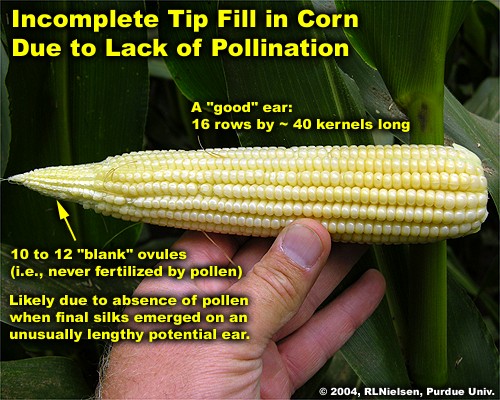
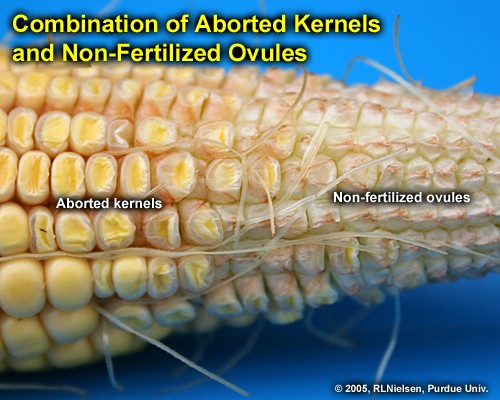
Kernel Abortion
Poor kernel set can also be a reflection of kernel abortion following successful fertilization of the ovules on the cob. In contrast to ineffective pollination, initial kernel development obviously precedes kernel abortion, so the symptoms are usually shriveled remnants of kernels that may be whitish- or yellowish-translucent.
Kernel abortion results from severe stresses that greatly reduce the overall photosynthetic output of the plant very early in the post-pollination grain-filling period. Obvious photosynthetic stressors include severe drought & heat stress, consecutive days of excessively cloudy weather and significant loss of photosynthetically active leaf area (e.g., hail damage, leaf diseases, insect damage, nutrient deficiency).
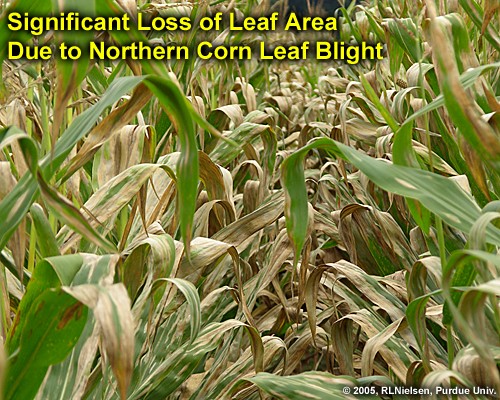
Warm nights during pollination and early grain fill may indirectly affect survival of developing kernels. Research suggests that the increased rate of kernel development due to warmer temperatures lowers the available amount of photosynthate per unit of thermal time; which then becomes a stressor to kernel development particularly at the tip of the ear, leading to kernel abortion (Cantarero et al., 1999).
Final Word to the Wise
A plethora (meaning a whole lot) of blank cob tips can quickly ruin the joy of walking a cornfield in the middle of August. Before getting too bent out of shape over the missing kernels, remember to count the number of harvestable kernels on those ears. Sometimes, ears exhibit 1 to 2 inches of blank tips; yet still contain 16 rows by 30 to 35 harvestable kernels per row. Those are perfectly acceptable ear sizes in a year where dry weather has been a concern.

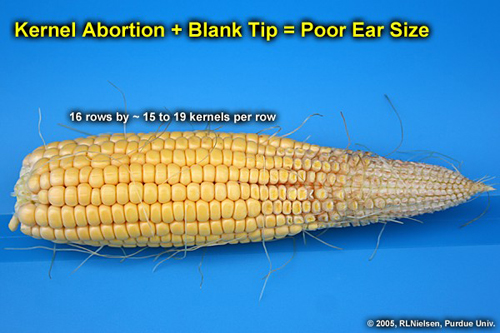
Related References
Cantarero, M.G., A.G. Cirilo, and F.H. Andrade. 1999. Night temperature at silking affects kernel set in maize. Crop Sci 39:703-710.
Nielsen, R.L. (Bob). 2004. Yield Loss Potential During Grain Fill. Corny News Network, Purdue Univ. [On-Line]. Available at <http://www.kingcorn.org/news/articles.04/GrainFillStress-0705.html> (URL accessed 7/13/07).
Nielsen, R.L. (Bob). 2007a. Estimating Corn Grain Yield Prior to Harvest. Corny News Network, Purdue Univ. [On-Line]. Available at <http://www.kingcorn.org/news/timeless/YldEstMethod.html> (URL accessed 7/13/07).
Nielsen, R.L. (Bob). 2007b. Grain Fill Stages in Corn. Corny News Network, Purdue Univ. [On-Line]. Available at <http://www.kingcorn.org/news/timeless/GrainFill.html> (URL accessed 7/13/07).
Nielsen, R.L. (Bob). 2007c. Silk Emergence. Corny News Network, Purdue Univ. Available [On-Line]. Available at <http://www.kingcorn.org/news/timeless/Silks.html> (URL accessed 7/13/07).
Nielsen, R.L. (Bob). 2007d. Tassel Emergence & Pollen Shed. Corny News Network, Purdue Univ. Available [On-Line]. Available at <http://www.kingcorn.org/news/timeless/Tassels.html> (URL accessed 7/13/07).
Univ. of Illinois. 2007. Estimating Corn Yields. (An Online Calculator). Illinois Agronomy Handbook. [On-Line]. Available at <http://www.ag.uiuc.edu/iah/index.php?ch=ch2/est_corn_yield.html> (URL accessed 7/13/07).
![]()



